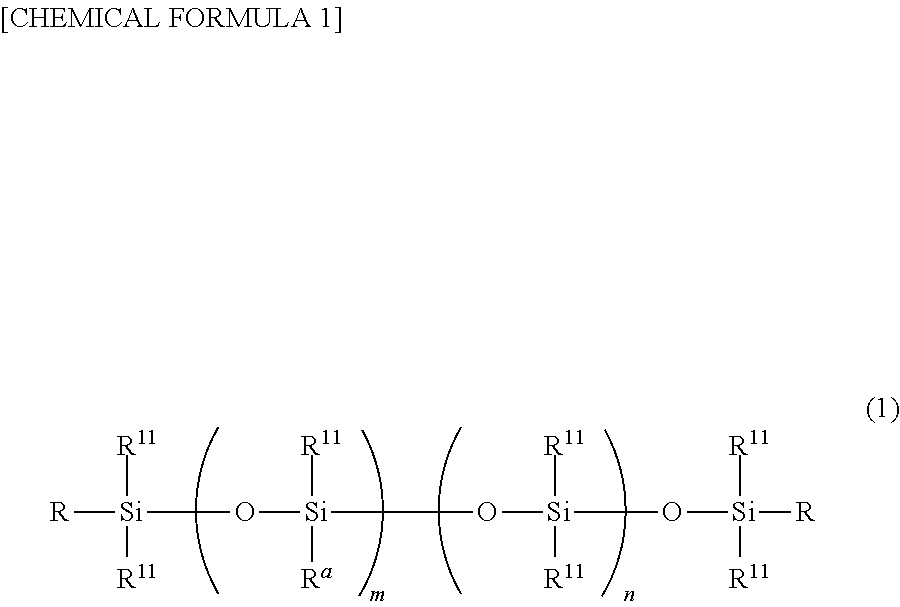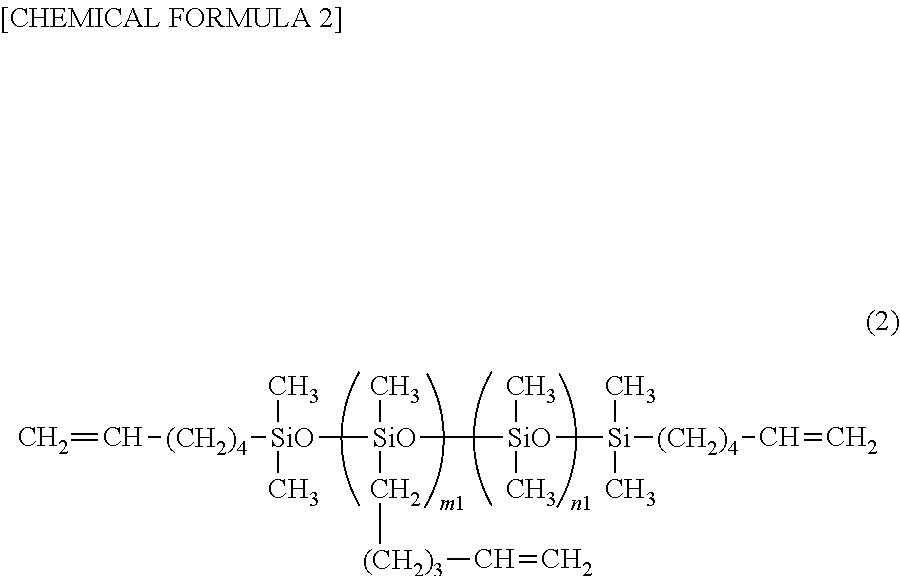Curable organopolysiloxane release agent composition for thermal paper, thermal paper, and thermal recording label sheet
a technology of organopolysiloxane and release agent, which is applied in the direction of film/foil adhesives, adhesives, coatings, etc., can solve the problems of color development, reduced adhesion, and unclear printing by the thermal head, and achieves superior handling, high adhesion, and adequate pot life.
- Summary
- Abstract
- Description
- Claims
- Application Information
AI Technical Summary
Benefits of technology
Problems solved by technology
Method used
Image
Examples
embodiment 1
[Embodiment 1] Composition 1
[0100]A curable organopolysiloxane composition was produced through uniformly mixing: (A) 93.76 parts of a polydimethyl sulfoxide having hexenyl groups on both ends of the molecular chain and on a side chain (viscosity of 200 mPa·s, with the inclusion proportion for the vinyl (CH2═CH—) part in the hexenyl groups being 1.15 mass %), (B1-1) 3.00 parts dimethyl methylhydrodiene polysiloxane blocked with trimethyl siloxy groups on both ends of the molecular chain, with a viscosity of 25 mPa·s, (B1-2) 3.00 parts dimethyl methylhydrodiene polysiloxane blocked with trimethyl siloxy groups on both ends of the molecular chain, with a viscosity of 20 mPa·s, (C) an amount of a chloroplatinic acid / 1,3-divinyl-1,1,3,3-tetramethyl disiloxane complex (platinum metal inclusion proportion: 0.6 mass %) such that the amounts of platinum metal in the overall composition were 195 and 260 ppm; and (D1) 0.23 parts 1-ethenyl-1-cyclohexanol (ETCH) and 0.01 parts methyl (tris (1,1...
embodiment 2
[Embodiment 2] Composition 2
[0101]A curable organopolysiloxane composition was produced in the same manner as in Embodiment 1, except for the further addition, to Composition 1, described above, of (E) 0.01 parts of diethoxy acetophenone. For the compositions with each of the amounts of platinum, cured layers were formed on thermally sensitive papers with the curing temperatures and curing times shown in Table 1, and the curabilities thereof are shown in Table 1. However, Composition 2 is ultraviolet radiation curable, and thus after the cured layer was formed on the thermally sensitive paper with the curing temperatures and curing times shown in Table 1 in a hot air circulating oven, it was further exposed to ultraviolet radiation (Eye Grande, by Eye Graphics Co., Ltd., total radiation dose: 110 mJ / cm2), to form a cured layer on the thermally sensitive paper, where the results of evaluations of curability, etc., are given in Table 1. The SiH / Vi ratio for Composition 2 was 1.95, the...
reference example 1
[Reference Example 1] Reference Composition 1
[0102]A curable organopolysiloxane composition was produced in the same manner as in Embodiment 1, except for mixing in (AX) 93.76 parts of a polydimethyl siloxane having vinyl groups on both ends of the molecular chain and on a side chain (viscosity: 200 mPa·s, vinyl (CH2═CH—) group inclusion proportion: 1.20 mass %), instead of the component (A), and, for Component (C), mixing in the platinum metal in amounts of 195, 260, and 325 ppm in the composition as a whole. For the compositions of each of the amounts of platinum, cured layers were formed on thermally sensitive papers through the curing temperatures and curing times shown in Table 1 in a hot air circulating oven, where the results of the evaluations of curability, and the like, are shown in Table 1. Note that in Reference Composition 1 the substance ratio of the silicon atom-bonded hydrogen atoms in the (B1-1) and (B1-2) components to the vinyl part in the (AX) component (=SiH / Vi ...
PUM
| Property | Measurement | Unit |
|---|---|---|
| viscosity | aaaaa | aaaaa |
| viscosity | aaaaa | aaaaa |
| viscosity | aaaaa | aaaaa |
Abstract
Description
Claims
Application Information
 Login to View More
Login to View More - R&D
- Intellectual Property
- Life Sciences
- Materials
- Tech Scout
- Unparalleled Data Quality
- Higher Quality Content
- 60% Fewer Hallucinations
Browse by: Latest US Patents, China's latest patents, Technical Efficacy Thesaurus, Application Domain, Technology Topic, Popular Technical Reports.
© 2025 PatSnap. All rights reserved.Legal|Privacy policy|Modern Slavery Act Transparency Statement|Sitemap|About US| Contact US: help@patsnap.com


